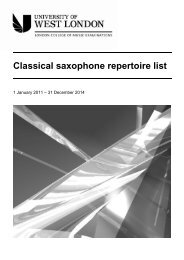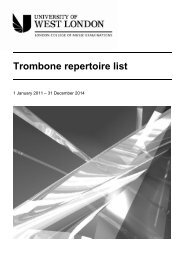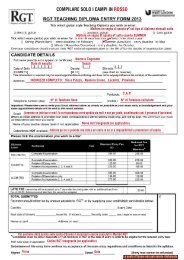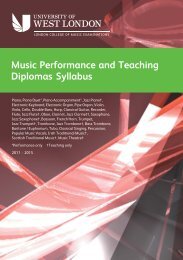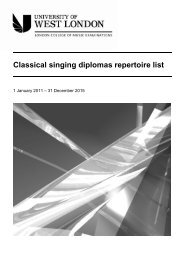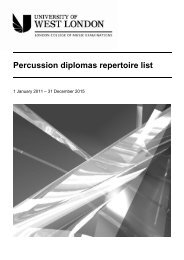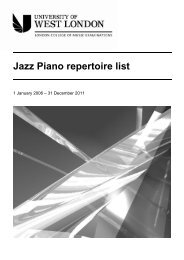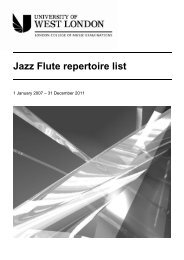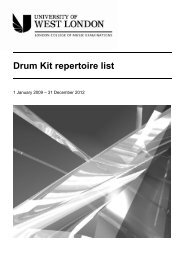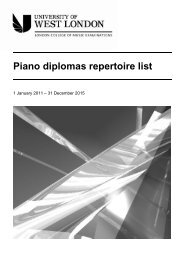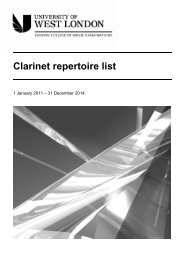LCM Exams - Trumpet Grades repertoire list - esamilcm.it
LCM Exams - Trumpet Grades repertoire list - esamilcm.it
LCM Exams - Trumpet Grades repertoire list - esamilcm.it
- No tags were found...
You also want an ePaper? Increase the reach of your titles
YUMPU automatically turns print PDFs into web optimized ePapers that Google loves.
<strong>Trumpet</strong> / Cornet / Flugelhorn <strong>repertoire</strong> <strong>list</strong>1 January 2011 – 31 December 2014
TRUMPET / CORNET / FLUGELHORN2011-2014ContentsPage<strong>LCM</strong> Publications ................................................................ 3Related Examinations ......................................................... 3Step 1 .................................................................................. 4Step 2 .................................................................................. 5Grade 1 ............................................................................... 6Grade 2 ............................................................................... 8Grade 3 ............................................................................... 10Grade 4 ............................................................................... 12Grade 5 ............................................................................... 14Grade 6 ............................................................................... 16Grade 7 ............................................................................... 18Grade 8 ............................................................................... 20Viva Voce ............................................................................ 22Aural Tests .......................................................................... 24This <strong>repertoire</strong> <strong>list</strong> should be read in conjunction w<strong>it</strong>h the Syllabus forGraded and Leisure Play Examinations in Music Performance. Copiesare available free of charge from <strong>LCM</strong> Examinations (tel: 020 8231 2364)or from local representatives, or on uwl.ac.uk/lcmexams.Leisure Play examinations are also available, for candidates who wish toplay pieces only. Please see Section 5 of the syllabus for details.This <strong>repertoire</strong> <strong>list</strong> is valid from 1 January 2011 until 31 December 2014.
<strong>LCM</strong> ExaminationsDirector of ExaminationsJohn Howard BA PhDChief Examiner in MusicPhilip Aldred BEd F<strong>LCM</strong>Univers<strong>it</strong>y of West London<strong>LCM</strong> ExaminationsSt Mary’s RoadEalingLondonW5 5RFtel: +44 (0)20 8231 2364fax: +44 (0)20 8231 2433email: lcm.exams@uwl.ac.ukuwl.ac.uk/lcmexams© Copyright 2011 by the Univers<strong>it</strong>y of West London, <strong>LCM</strong> Examinations2
AcknowledgementGrateful thanks are due to Ray Bidwell, the principal syllabus compiler.<strong>LCM</strong> PublicationsThe following <strong>LCM</strong> Publications are relevant to this syllabus:• Specimen Aural Tests (revised 2006) (LL189)• <strong>LCM</strong> Aural Handbook: A Practical Guide to Teaching and Preparing for <strong>LCM</strong> Aural Tests (LL205)<strong>LCM</strong> Publications are distributed by Music Exchange (tel: 0161 946 9301; email: mail@music-exchange.co.uk).A complete <strong>list</strong> of t<strong>it</strong>les may be found on their webs<strong>it</strong>e – www.music-exchange.co.ukRelated Examinations<strong>LCM</strong> Examinations offers examinations in a wide range of subjects, covering classical, jazz, pop/rock andtrad<strong>it</strong>ional music genres. The following syllabuses may also be of interest.Graded and leisure play examinations for:• French Horn, Trombone, Bar<strong>it</strong>one / Euphonium, Tuba.• Jazz <strong>Trumpet</strong>, Jazz Trombone.Performance diplomas (four levels) and teaching diplomas (three levels) for:• French Horn, <strong>Trumpet</strong>, Trombone, Bass Trombone, Bar<strong>it</strong>one / Euphonium, Tuba.• Jazz <strong>Trumpet</strong>, Jazz Trombone.A flexible Ensemble syllabus is also available, catering for all types of ensemble from duets and trios up to concertbands and brass bands. Six levels are offered, ranging from Grade 1/2 to Dip<strong>LCM</strong> standard.Syllabuses are available free of charge from the <strong>LCM</strong> <strong>Exams</strong> office or from local representatives, or may bedownloaded from the <strong>LCM</strong> <strong>Exams</strong> webs<strong>it</strong>e.3
TRUMPET: INTRODUCTORY EXAMSCandidates for Step One and Step Two examinations will find all the required material in:<strong>Trumpet</strong> Basics by John Miller (Faber Music)Exercises should be played unaccompanied.Studies and pieces may be played unaccompanied, or w<strong>it</strong>h simple supporting instrumentalaccompaniment, provided that this has been agreed and rehearsed in conjunction w<strong>it</strong>h the teacherand/or candidate ahead of the examination. Alternatively, accompaniments from the Teacher’s Book orthe Accompaniment CD may be used.TRUMPET: STEP ONEComponent 1 - Exercises25 marksCandidates should play all of the following:Mouthpiece Buzzing 2 (page 10)Count as You Play (page 11)Mind Your Fingers (page 12)How It Works (page 14)Smooth ‘n’ Groovy (page 15)Component 2 - Studies20 marksCandidates should play both of the following:Quick March (page 10)Lightly Row (page 12)Component 3 - Pieces40 marksCandidates should play both of the following:Hansel and Gretel (page 12)O When the Saints (page 15)Component 4 - Questions on Rudiments15 marksRecogn<strong>it</strong>ion/identification of staff, bar-lines, p<strong>it</strong>ch names, note types and values, rest values, all relating to themusic performed.4
TRUMPET: STEP TWOComponent 1 - Exercises25 marksCandidates should play all of the following:The Six Steps (page 16)Warm Up Those Chops (page 16)Smooth as Silk (page 20)Slurring Down (page 26)Chops Exercise (page 28)Component 2 - Studies20 marksCandidates should play both of the following:The Green Man (page 16)Brother Martin’s Round (page 22)Component 3 - Pieces40 marksCandidates should play both of the following:Macdonald’s Echo (page 17)Lottery Loser (page 19)Component 4 - Questions on Rudiments15 marksAs for Step One, but now including dotted note values and knowledge about the pos<strong>it</strong>ion and purpose of the keyand time signature, accidentals and basic dynamic signs. All relating to the music performed.5
TRUMPET: GRADE ONEComponent 1 - Technical Work15 marksFLEXIBILITYRIDGEON No.1 from How Brass Players Do It (Brass Wind)SCALES AND ARPEGGIOS (ascending and descending, from memory)(suggested tempo: m.m. crotchet = 60 when played in quavers)Scales and Arpeggios in the following keys and ranges:Scales to be played tongued and slurred.Arpeggios to be played tongued only.Keys1 octavemelodic OR harmonic(candidate’s choice)C majorA minor Component 2 - Performance60 marksPerformance of three pieces, one from each <strong>list</strong>: A, B and C.LIST ACALLAND Jump To It from Top Brass (Stainer & Bell)DAVIS Tiny Minuet from Polished Brass (Brass Wind)GREGSON Hungarian Dance (No.4) OR Lullaby (No.8) from 20 Supplementary Tunes for Beginner Brass(Brass Wind)MILLER No.11 OR No.14 from Simple Studies for Beginner Brass (Faber)WIGGINS No.12 OR No.24 from Tunes and Studies for the <strong>Trumpet</strong>, Book 1 (OUP)LIST BBACH Chorale from Amazing Solos (arr. Harrison) (Boosey & Hawkes)DIABELLI Allegretto from <strong>Trumpet</strong> Fancies (arr. Stuart) (Boston Music / Music Sales)HANDEL See, the Conquering Hero Comes from Up-Grade! <strong>Trumpet</strong> <strong>Grades</strong> 1-2 (arr. Wedgwood) (Faber)HAYDN Minuet from Bravo! <strong>Trumpet</strong> (arr. Barratt) (Boosey & Hawkes)PLEYEL Minuet from <strong>Trumpet</strong> Fancies (arr. Stuart) (Boston Music / Music Sales)SUSATO Ronde from <strong>Trumpet</strong> Basics (p.34) (Faber)LIST CCOOMBES <strong>Trumpet</strong> in Traffic from Keynotes Album for <strong>Trumpet</strong> (Brass Wind)DYLAN Blowing in the Wind from Winners Score All (arr. Lawrance) (Brass Wind)GREGSON No.1 (Prelude) OR No.2 (Ostinato) from Ten Miniatures for <strong>Trumpet</strong> (Brass Wind)LYONS Journey’s End OR Miles Away from The Really Easy <strong>Trumpet</strong> Book (Faber)MILLER The Ballad of the East Neuk from <strong>Trumpet</strong> Basics (p.35) (Faber)RAMSKILL Music Hall Song from Keynotes Album for <strong>Trumpet</strong> (Brass Wind)RUNSWICK Offshore from Up Front Album for <strong>Trumpet</strong>, Book 1 (Brass Wind)WEDGWOOD Apple Pie Waltz OR I Believe from Up-Grade! <strong>Trumpet</strong> <strong>Grades</strong> 1-2 (Faber)WALLACE Stokes’ Stomp from First Book of <strong>Trumpet</strong> Solos (Faber)WIGGINS Steal Away from Beginners Please! (Winwood)6
Component 3 - Viva Voce7 marksSee pages 22-23.Component 4 - Sight Reading10 marksUp to one minute’s preparation time will be allowed to study the test before playing, during which the candidate may tryparts of the test if they wish.Component 5 - Aural Tests8 marksSee pages 24-28. Specimen tests and a handbook are available (details on page 3).9
TRUMPET: GRADE THREEComponent 1 - Technical Work15 marksFLEXIBILITYRIDGEON No.7 OR No.8 from How Brass Players Do It (Brass Wind)SCALES AND ARPEGGIOS (ascending and descending, from memory)(suggested tempo: m.m. crotchet = 60 when played in quavers)Scales and Arpeggios in the following keys and ranges, to be played tongued and slurred, piano and forte:Keys 1 octave melodic AND harmonicEb majorE majorA majorE minor C minor Chromatic Scale starting on C (1 octave)Whole Tone Scale Starting on C (1 octave)Component 2 - Performance60 marksPerformance of three pieces, one from each <strong>list</strong>: A, B and C.LIST ACALLAND Tongue-twister OR Wistful Waltz from Top Brass (Stainer & Bell)DAVIS Smart Card from Polished Brass (Brass Wind)GREGSON No.15 OR No.17 OR No.19 from 20 Supplementary Tunes for Beginner Brass (Brass Wind)HERING No.8 OR No.9 OR No.12 from 40 Progressive Etudes for <strong>Trumpet</strong> (Carl Fischer)MILLER No.27 OR No.34 OR No.38 from Simple Studies for Beginner Brass (Faber)WIGGINS No.53 from Tunes and Studies for <strong>Trumpet</strong>, Book 1 (OUP)LIST BANON. All in a Garden Green from Going Solo <strong>Trumpet</strong> (Faber)MONTEVERDI The Palace Garden from First Book of <strong>Trumpet</strong> Solos (Faber)MUSSORGSKY Promenade from First Repertoire for <strong>Trumpet</strong> (arr. Calland) (Faber)PURCELL <strong>Trumpet</strong> Air from Old English <strong>Trumpet</strong> Tunes, Book 1 (OUP)PURCELL <strong>Trumpet</strong> Tune, No.5 from First Repertoire Pieces for <strong>Trumpet</strong> (arr. Wastall) (Boosey & Hawkes)TRAD. Byker Hill from Amazing Solos (arr. Harrison) (Boosey & Hawkes)LIST CBART I’d Do Anything from Winners Score All (arr. Lawrance) (Brass Wind)BULLARD Sad Clown OR Sentimental Serenade from Circus Skills (Spartan Press)GODDARD Swingin’ from Party Pieces for <strong>Trumpet</strong> <strong>Grades</strong> 2-5 (Spartan Press)GREGSON No.4 (Rhythmic Dance) OR No.6 (Minuet) OR No.7 (Slightly Slavic) from Ten Miniaturesfor <strong>Trumpet</strong>(Brass Wind)JOPLIN The Easy Winners from Up-Grade! <strong>Trumpet</strong> <strong>Grades</strong> 2-3 (Faber)NORTON Stately Dance OR Big Time from The Microjazz <strong>Trumpet</strong> Collection 2 (Boosey & Hawkes)PEARSON Br<strong>it</strong>ish Grenadiers from Going Solo <strong>Trumpet</strong> (Faber)PROKOFIEFF Troika from Amazing Solos (arr. Harrison) (Boosey & Hawkes)RAE A Question of Cool from Fingerprints <strong>Grades</strong> 1-4 (Faber)SCHUMAN Flying High OR First Tango from <strong>Trumpet</strong> Trix (Spartan Press)10
Component 3 - Viva Voce7 marksSee pages 22-23.Component 4 - Sight Reading10 marksUp to one minute’s preparation time will be allowed to study the test before playing, during which the candidate may tryparts of the test if they wish.Component 5 - Aural Tests8 marksSee pages 24-28. Specimen tests and a handbook are available (details on page 3).11
TRUMPET: GRADE FOURComponent 1 - Technical Work15 marksFLEXIBILITYRIDGEON No.9 OR No.11 from How Brass Players Do It (Brass Wind)SCALES AND ARPEGGIOS (ascending and descending, from memory)(suggested tempo: m.m. crotchet = 72 when played in quavers)Scales and Arpeggios in the following keys and ranges, to be played tongued and slurred, piano and forte:Keys 1 octave a twelfth melodic AND harmonicF majorA majorBb majorAb majorC# minor F minor D minor Chromatic Scale starting on B flat (a twelfth)Whole Tone Scale starting on F (1 octave)Component 2 - Performance60 marksPerformance of three pieces, one from each <strong>list</strong>: A, B and C.LIST ACALLAND Lonely Town from Top Brass (Stainer & Bell)CLARKE Weldon OR Polish Dance from Featuring Rhythm for Treble Brass (Brass Wind)DAVIS Wipe Out OR Irish Jig from Polished Brass (Brass Wind)GREGSON No.18 OR No.20 (complete) from 20 Supplementary Tunes (Brass Wind)HERING No.13 OR No.17 from 40 Progressive Etudes (Carl Fischer)MILLER No.1 OR No.4 from Progressive Brass Studies for <strong>Trumpet</strong> (Faber)WIGGINS No.102 from Tunes and Studies for <strong>Trumpet</strong>, Book 1 (OUP)LIST BANON.The Lord Mayor’s Swan Hopping <strong>Trumpet</strong> Tune from First Repertoire Pieces for <strong>Trumpet</strong>(arr. Wastall)(Boosey & Hawkes)ARBAN Vois-Tu La Neige Qui Brille? from Second Book of <strong>Trumpet</strong> Solos (Faber)BYRD John Come Kiss Me Now from Going Solo <strong>Trumpet</strong> (Faber)HANDEL March from Scipio from Old English <strong>Trumpet</strong> Tunes, Book 1 (OUP)MOZART Canzona, No.4 from First Repertoire Pieces for <strong>Trumpet</strong> (arr. Wastall) (Boosey & Hawkes)PURCELL Fairest Isle from Going Solo <strong>Trumpet</strong> (Faber)LIST CBULLARD Russian Galop from Circus Skills (Spartan Press)CALLAND Twilight in Paris from Fingerprints <strong>Grades</strong> 1-4 (Faber)GLYN Stomp from Star Turn (Spartan Press)GODDARD Hornpipe from Party Pieces <strong>Grades</strong> 2-5 (Spartan Press)GRAINGER Doctor Who from Winners Score All (arr. Lawrance) (Brass Wind)GREGSON No.8 (Folk Dance) from Ten Miniatures for <strong>Trumpet</strong> (Brass Wind)GREGSON Intrada from Cameos (Brass Wind)MORROSS The Big Country from Some Might Say Prokofiev (Brass Wind)NORTON Bright Spark from The Microjazz <strong>Trumpet</strong> Collection 2 (Boosey & Hawkes)SCHUMAN A Busy Day from <strong>Trumpet</strong> Trix (Spartan Press)12
Component 3 - Viva Voce7 marksSee pages 22-23.Component 4 - Sight Reading10 marksUp to one minute’s preparation time will be allowed to study the test before playing, during which the candidate may tryparts of the test if they wish.Component 5 - Aural Tests8 marksSee pages 24-28. Specimen tests and a handbook are available (details on page 3).13
TRUMPET: GRADE FIVEComponent 1 - Technical Work15 marksFLEXIBILITYRIDGEON No.13 OR No.14 from How Brass Players Do It (Brass Wind)SCALES AND ARPEGGIOS (ascending and descending, from memory)(suggested tempo: m.m. crotchet = 72 when played in quavers)Scales and Arpeggios in the following keys and ranges, to be played tongued and slurred, piano and forte:Keys a twelfth 2 octaves melodic AND harmonicG majorC majorB majorDb majorA majorG minor C minor B minor A minor Chromatic Scale starting on C (a twelfth) and G (2 octaves)Whole tone scale starting on G (2 octaves)Dominant 7th in the key of G (1 octave)Component 2 - Performance60 marksPerformance of three pieces, one from each <strong>list</strong>: A, B and C.LIST ABOURGEOIS No.9 OR No.10 from Ace Of <strong>Trumpet</strong>s (Brass Wind)CLARKE Pandora OR Cossack Dance OR Castletown from Featuring Rhythm forTreble Brass(Brass Wind)DAVIS Horse and Stripes OR Hornpipe OR Heads or Tails from Polished Brass (Brass Wind)HERING No.30 OR No.33 from 40 Progressive Etudes (Carl Fischer)MILLER No.5 OR No.6 from Progressive Brass Studies for <strong>Trumpet</strong> (Faber)WEALE No.9 OR No.11 from Challenging Brass (Rosehill)WIGGINS No.88 OR 97 from Tunes and Studies for the <strong>Trumpet</strong>, Book 1 (OUP N9517)LIST BBACH Gigue from Some Might Say Prokofiev (Brass Wind)CLARKE The Prince of Denmark’s March from Old English <strong>Trumpet</strong> Tunes, Book 1 (OUP)HUMMEL No.24 Indian Rondo from First Book of <strong>Trumpet</strong> Solos (Faber)MOLTER Adagio from Baroque Music for <strong>Trumpet</strong> (Boosey & Hawkes)PURCELL First movement from <strong>Trumpet</strong> Sonata from Old English <strong>Trumpet</strong> Tunes, Book 1 (OUP)TELEMANN Air from The Baroque <strong>Trumpet</strong> (arr. Miller) (Faber)LIST CCHAMBERS Angels from Lets Face The Music (arr. Iveson) (Brass Wind)ELLERBY Frascati’s OR Gazing Rustics from Mercurial Dances (Brass Wind)GLYN Good News from Star Turn (Spartan Press)GODDARD Daydreams OR Ragamuffin from Party Pieces <strong>Grades</strong> 2-5 (Spartan Press)GORB Oussoul OR Huapango from A Tango to Bali (Brass Wind)14
GREGSON Alla Marcia OR Canon Dance from Cameos for <strong>Trumpet</strong> (Brass Wind)GRUNDMAN Conversation for Cornet from First Repertoire Pieces for <strong>Trumpet</strong> (arr. Wastall) (Boosey & Hawkes)JOPLIN Maple Leaf Rag from Second Book of <strong>Trumpet</strong> Solos (Faber)PEETERS Aria from <strong>Trumpet</strong> Sonata Op.51 (Peters)WILLIAMS Raiders March from Great Winners (arr. Lawrance) (Brass Wind)WOOLFENDEN Ushercombe View OR Tah<strong>it</strong>ian Tango from Landmarks for <strong>Trumpet</strong> (Brass Wind)Component 3 - Viva Voce7 marksSee pages 22-23.Component 4 - Sight Reading10 marksUp to one minute’s preparation time will be allowed to study the test before playing, during which the candidate may tryparts of the test if they wish.Component 5 - Aural Tests8 marksSee pages 24-28. Specimen tests and a handbook are available (details on page 3).15
TRUMPET: GRADE SIXComponent 1 - Technical Work15 marksFLEXIBILITYRIDGEON No.17 OR No.18 from How Brass Players Do It (Brass Wind)SCALES AND ARPEGGIOS (ascending and descending, from memory)(suggested tempo: m.m. crotchet = 60 when played in semiquavers)Scales and Arpeggios in the following keys and ranges, to be played tongued and slurred, piano and forte:Keys 1 octave a twelfth 2 octaves melodic AND harmonicAb majorA majorF# major D majorF# minor A minor C# minor F minor Chromatic scales starting on F sharp, G, A flat, A (2 octaves)Dominant 7th in the key of C, D flat, D (2 octaves)Diminished 7th starting on G (2 octaves)Whole tone scale starting on C sharp (a twelfth)Component 2 - Performance60 marksPerformance of three pieces, one from each <strong>list</strong>: A, B and C.LIST AARBAN No.5 from 14 Studies for Cornet (Boosey & Hawkes)BOURGEOIS No.8 from Ace of <strong>Trumpet</strong>s (Brass Wind)CLARKE Ryedale OR Processional from Featuring Rhythm for Treble Brass (Brass Wind)HERING No.34 OR No.35 from 40 Progressive Etudes (Carl Fischer)MILLER No.11 OR No.13 from Progressive Brass Studies for <strong>Trumpet</strong> (Faber)PIPER No.2 OR No.20 from The Well Tempered Player (Winwood)WEALE No.14 OR No.15 from Challenging Brass (Rosehill)LIST BBANCHIERI Canzona 5 from The Baroque <strong>Trumpet</strong> (arr. Miller) (Faber)BOYCE No.13 <strong>Trumpet</strong> Voluntary from Old English <strong>Trumpet</strong> Tunes, Book 1 (OUP N7542)CLARKE Prince Eugene’s March AND <strong>Trumpet</strong> Minuet from Shore’s Musick (McNaughton MN30033)HANDEL Ev’ry Valley Shall Be Exalted from Three Handel Arias (Studio Music)HAYDN Andante, second movement from Concerto in E flat (B flat <strong>Trumpet</strong> version) (Boosey & Hawkes)PURCELL First OR Third movement from Sonata for <strong>Trumpet</strong> (Musica Rara MR1073)LIST CBIZET Flower Song from Six Celebrated Solos (arr. Calland) (Stainer & Bell)BURGON Toccata (Stainer & Bell)DVOŘÁK Rusalka’s Song to the Moon from Shepherd’s Song (Winwood)ELGAR Serenade (arr. Wilson) (Winwood)ELLERBY Experiments from Mercurial Dances (Brass Wind)GORB Tango Argentino from A Tango to Bali (Brass Wind)16
GREGSON Danse Macabre from Cameos for <strong>Trumpet</strong> (Brass Wind)MICHAEL / RIDGELEYCareless Whisper from Let’s Face The Music (arr. Iveson)(Brass Wind)OTTO Third movement from <strong>Trumpet</strong> Concerto in Eb (Brass Wind)PARKER Theme from Another Six English Towns (Studio Music)SANDERS Square Dance (Stainer & Bell)SPARKE Soliloquy for B flat Cornet (Studio Music)WOOLFENDEN Gorky Park OR In Memoriam-Yukovar OR Mean Streets of Miami fromLandmarks for <strong>Trumpet</strong>(Brass Wind)Component 3 - Viva Voce7 marksSee pages 22-23.Component 4 - Sight Reading10 marksUp to one minute’s preparation time will be allowed to study the test before playing, during which the candidate may tryparts of the test if they wish.Component 5 - Aural Tests8 marksSee pages 24-28. Specimen tests and a handbook are available (details on page 3).17
TRUMPET: GRADE SEVENComponent 1 - Technical Work15 marksFLEXIBILITYRIDGEON No.19 OR No.21 OR No.23 OR No.24 from How Brass Players Do It (Brass Wind)SCALES AND ARPEGGIOS (ascending and descending, from memory)(suggested tempo: m.m. crotchet = 60 when played in semiquavers)Scales and Arpeggios in the following keys and ranges, to be played tongued and slurred, piano and forte:Keys a twelfth 2 octaves melodic AND harmonicBb majorB majorC# major Eb majorE majorBb minor Eb minor D minor E minor Ab minor Chromatic scales starting on B flat and B (2 octaves)Dominant 7th in the key of B flat and Ab (1 octaves); Eb (2 octaves)Diminished 7th starting on A flat and A (2 octaves)Component 2 - Performance60 marksPerformance of three pieces, one from each <strong>list</strong>: A, B and C.LIST AARBAN No.1 OR No.6 OR No.10 from 14 Studies for Cornet (Boosey & Hawkes)BOURGEOIS No.1 OR No.3 from Fantasy Pieces (Brass Wind)CLARKE No.6 OR No.9 from Characteristic Studies (Carl Fischer)HERING No.38 OR No.39 from 40 Progressive Etudes (Carl Fischer)KOPPRASCH No.34 from 60 Selected Studies, Book 1 (Carl Fischer)MILLER No.21 from Progressive Brass Studies for <strong>Trumpet</strong> (Faber)PIPER No.17 from The Well Tempered Player (Rosehill)WEALE No.22 OR No.29 from Challenging Brass (Rosehill)LIST BFANTINI Sonata Detta Del Niccolini from The Baroque <strong>Trumpet</strong> (arr. Miller) Faber)HANDEL Oh Had I Jubal’s Lyre from Three Handel Arias (Studio Music)HUMMEL The Noble Savage from Second Book of <strong>Trumpet</strong> Solos (Faber)KELLER Sonata No.2 (Complete) from Baroque Music for <strong>Trumpet</strong> (Boosey & Hawkes)PURCELL Sound the <strong>Trumpet</strong> from The Duke of Gloucester’s Birthday Ode (Fentone / De Haske)STANLEY <strong>Trumpet</strong> Voluntary from Old English <strong>Trumpet</strong> Tunes, Book 1 (OUP)LIST CBOZZA Badinage (Leduc / UMP)COPLAND Laurie’s Song from Copland for <strong>Trumpet</strong> (Boosey & Hawkes)DEBUSSY The Girl w<strong>it</strong>h the Flaxen Hair (arr. Wilson) (Winwood)ELGAR Idylle from Second Book of <strong>Trumpet</strong> Solos (Faber)18
ELLERBY The Defence of Poesy from Mercurial Dances (Brass Wind)GERSHWIN No.1 OR No.2 from Three Preludes (arr. Kearns) (Stainer & Bell)GORB Chikona from A Tango to Bali (Brass Wind)GRAHAM A Time for Peace from Gramercy Solo Album (Bb) (Gramercy)HIMES First movement from Concertino for Flugel Horn (Studio Music)HOROVITZ Second movement from Concerto for <strong>Trumpet</strong> (Novello / Music Sales)HUBEAU First movement from Sonata for <strong>Trumpet</strong> (Durand / UMP)LAUE First and Second movements from <strong>Trumpet</strong> Concerto in D (Brass Wind)MARTINŮ Sonatine (Leduc / UMP)NERUDA Second movement from Concerto in Eb (Brass Wind)PEETERS First movement from Sonata for <strong>Trumpet</strong> (Peters)SHOSTAKOVICH Prelude 18 from Russian Roulette (Brass Wind)WALLACE The Moose is Loose from Second Book of <strong>Trumpet</strong> Solos (Faber)ZUBIAURRE Aud<strong>it</strong>ion Piece for <strong>Trumpet</strong> (Brass Wind)Component 3 - Viva Voce7 marksSee pages 22-23.Component 4 - Sight Reading10 marksUp to one minute’s preparation time will be allowed to study the test before playing, during which the candidate may tryparts of the test if they wish.Component 5 - Aural Tests8 marksSee pages 24-28. Specimen tests and a handbook are available (details on page 3).19
TRUMPET: GRADE EIGHTTheory of Music Grade Five must have been passed (see Regulations in the syllabus).Component 1 - Technical Work15 marksFLEXIBILITYRIDGEON No.27 OR No.28 from How Brass Players Do It (Brass Wind)SCALES AND ARPEGGIOS (ascending and descending, from memory)(suggested tempo: m.m. crotchet = 72 when played in semiquavers)Scales and Arpeggios in the following keys and ranges, to be played tongued and slurred, piano and forte:Keys a twelfth 2 octaves melodic AND harmonicThe major scales from F# - CThe major scales from C# - FThe minor scales from F# - C The minor scales from C# - F Whole tone scale starting on A flat and C (2 octaves)Augmented arpeggio starting on G, C, A and B flat (2 octaves)Diminished 7th starting on F sharp, G and A flat (2 octaves)Dominant 7th in the key of B, E and F (2 octaves); F# (1 octave)Chromatic scales starting on any note between F sharp and C (2 octaves)Component 2 - Performance60 marksPerformance of three pieces, one from each <strong>list</strong>: A, B and C.LIST AARBAN No.2 OR No.9 from 14 Studies for Cornet (Boosey & Hawkes)BOURGEOIS No.4 OR No.6 OR No.8 from Fantasy Pieces (Brass Wind)FALK Parade from 20 Etudes Atonales (Leduc / UMP)MILLER No.25 OR No.30 from Progressive Brass Studies for <strong>Trumpet</strong> (Faber)PIPER No.5 OR No.6 from The Well Tempered Player (Winwood)SMITH No.1 OR No.5 from Top Tones for <strong>Trumpet</strong> (Carl Fischer)LIST BALBINONISecond AND Fourth movements from Concerto in G minor (Ed<strong>it</strong>ions Marc Reift 626 / MusT)HANDEL Let the Bright Seraphim (Presser)HAYDN First OR Third movement from Concerto in E flat (Boosey & Hawkes)HUMMEL First OR Third movement from Concerto in E flat (Boosey & Hawkes)TELEMANN Allegro, Second movement from Concerto in D (Sikorski / Elkin Music Services)TORELLI Concerto in D (complete) (Musica Rara MR1155)LIST CABREU Tico Tico (Brass Wind)BELLSTEDT Napoli from Shepherd’s Song (Winwood)BOURGEOIS Third movement from Sonata for <strong>Trumpet</strong> Op.193 (Brass Wind)BOZZA Caprice No.2 (Leduc / UMP)BUSSER Andante et Scherzo (Leduc / UMP)COPLAND Fanfare for the Common Man from Copland for <strong>Trumpet</strong> (Boosey & Hawkes)GOLLAND Ballade Op.72, No.1 (Studio Music)GRAHAM Whirlwind from Gramercy Solo Album Bb (Gramercy)GREGSON Prelude and Capriccio (R Sm<strong>it</strong>h)20
HUBEAU Third movement (Spir<strong>it</strong>ual) from Sonate for <strong>Trumpet</strong> (Durand / UMP)LLOYD WEBBER Second, Third and Fourth movements from Su<strong>it</strong>e in F (Stainer & Bell)NERUDA First OR Third movement from Concerto in E flat (Brass Wind)NEWSOME Concorde (Studio Music)PEETERS Third movement from Sonata for <strong>Trumpet</strong> Op.51 (Peters)PROCTOR The Huffle (Brass Wind)SPARKE First OR Third movement from Concerto for Cornet (Studio Music)TCHAIKOVSKY Ballet Su<strong>it</strong>e from Russian Roulette Brass Wind)WRIGHT First OR Third movement from Concerto for Cornet (Studio Music)Component 3 - Viva Voce7 marksSee pages 22-23.Component 4 - Sight Reading10 marksUp to one minute’s preparation time will be allowed to study the test before playing, during which the candidate may tryparts of the test if they wish.Component 5 - Aural Tests8 marksSee pages 24-28. Specimen tests and a handbook are available (details on page 3).21
Viva VoceNotes:1. All questions and answers are verbal. Candidates are not expected to demonstrate on their instrument or tosing; but they may choose to do so if they feel that this would clarify their answer.2. There is no set form of words, or number of questions. Examiners are encouraged to conduct the tests in aflexible and conversational manner. The number of questions asked, and the content of the questions, maydiffer from candidate to candidate. However, the prime focus for the Viva Voce will always be the musicperformed in the Performance section of the exam.3. The knowledge required for the Viva Voce is cumulative for <strong>Grades</strong> 1-8; i.e. any knowledge required in earliergrades is required for later grades.4. Although accuracy and appropriateness of response are the principal cr<strong>it</strong>eria of assessment, examiners willalso look for articulacy, use of correct terminology, and a sense of engagement w<strong>it</strong>h, and understanding of, themusic performed.Requirements:GRADES 1 AND 2Candidates should be able to:• name, and explain the meaning of, all basic notational elements in the music performed in the Performancecomponent of the exam, including: staff, bars and bar-lines, clefs, p<strong>it</strong>ches of individual notes, rhythmic valuesof notes and rests (including dotted notes), key and time signatures, accidentals, dynamics, articulationmarkings, phrases, ornaments, and any add<strong>it</strong>ional markings;• explain which is their favour<strong>it</strong>e piece and why;• assign simple descriptive words to pieces to describe their mood ('happy', 'sad', 'bouncy', 'jazzy', 'gentle',etc.)GRADE 3In add<strong>it</strong>ion to the requirements for <strong>Grades</strong> 1 and 2, candidates may be asked to:• identify intervals up to and including a fifth by numerical value only (e.g. 'second', 'fourth', etc.);• describe the mood or character of pieces using appropriate descriptive terminology ('fast and lively', 'gentleand flowing', 'like a dance', etc.);• identify contrasts of mood w<strong>it</strong>hin pieces;• discuss any pictorial or descriptive element of the music.GRADE 4In add<strong>it</strong>ion to the requirements for <strong>Grades</strong> 1-3, candidates may be asked to:• identify intervals up to and including an octave by numerical value only (e.g. 'fourth', 'seventh', etc.);• demonstrate basic knowledge of composers of the music performed, including their national<strong>it</strong>y andapproximate dates;• discuss their approaches to learning the pieces, and to identify any particular difficulties (musical ortechnical) which were encountered;• demonstrate a basic understanding of the workings of their instrument, and to name <strong>it</strong>s principal const<strong>it</strong>uentparts.22
GRADE 5In add<strong>it</strong>ion to the requirements for <strong>Grades</strong> 1-4, candidates may be asked to:• identify intervals up to and including an octave by number and type (e.g. 'Major 2nd', 'Perfect 4th', etc.);• demonstrate knowledge of basic formal structures (e.g. contrasting or repeated sections);• identify principal modulations (by naming the new key or <strong>it</strong>s relationship to the home key);• identify major and minor chords as occurring in the music (e<strong>it</strong>her as chords or as melodic patterns);• identify the historical period of the music performed (Renaissance, Baroque, etc.).GRADE 6In add<strong>it</strong>ion to the requirements for <strong>Grades</strong> 1-5, candidates may be asked to:• discuss their personal responses to the music performed: the extent to which they like or dislike <strong>it</strong>, or find <strong>it</strong>challenging or rewarding, and why;• approaches to learning the music, including the use of certain techniques, and aspects of interpretation;• identify melodic and harmonic features of the music (e.g. sequence, melodic inversion, circle of 5ths, pedalpoints, etc.);• demonstrate knowledge of formal structures (e.g. ternary, binary, rondo etc.);• demonstrate a self-cr<strong>it</strong>ical awareness of their own performance, indicating to the examiner which aspects oftheir performance they were happy or unhappy w<strong>it</strong>h, and why.GRADE 7In add<strong>it</strong>ion to the requirements for <strong>Grades</strong> 1-6, candidates may be asked to:• identify more complex chords, including sevenths and dissonances, as occurring in the music (e<strong>it</strong>her aschords or as melodic patterns);• identify cadences;• give basic biographical information about the composers of the music performed;• demonstrate awareness of the historical and sty<strong>list</strong>ic context of the music;• demonstrate a widening musical awareness a l<strong>it</strong>tle beyond the music performed.GRADE 8In add<strong>it</strong>ion to the requirements for <strong>Grades</strong> 1-7, candidates may be asked to:• demonstrate knowledge of other music by the same composers;• identify any interval by number and type;• discuss w<strong>it</strong>h the examiner a range of issues arising from the music performed, demonstrating evidence of arounded musical awareness, in terms both of the <strong>repertoire</strong> <strong>it</strong>self, and the candidate's response to <strong>it</strong> as aperformer.23
Aural TestsNotes:1. GRADE 1 TEST 1(b); GRADE 3 TEST 2(b): where a candidate wishes to respond to e<strong>it</strong>her of these tests inthe alternative manner as specified, the examiner must be informed in advance of the tests beingadministered. This may be done e<strong>it</strong>her via the Centre representative or attendant on the day (in advance of theexamination), or by the candidate (in the examination, in advance of the tests).2. In tests where the identification of note values (rhythmic values) is required, such as Grade 2, test 1(c),candidates are required to respond by <strong>list</strong>ing the rhythmic values in the order in which they occur in theextract, e.g. 'minim, crotchet, crotchet' or 'minim, four quavers'.3. In tests where a sung response is required, candidates may use any clear and appropriate syllable or vowelsound (e.g. 'ah', 'la', 'oo', etc.) They may also hum or whistle. Candidates may request tests to be transposed ifrequired by their vocal range. Candidates may play back such tests on their instrument if they prefer; in thiscase, examiners must be informed prior to the administration of the tests (see note 1 above).4. In tests where responses describing p<strong>it</strong>ch are required, candidates may use letter-names (A, B, C, etc.), tonicsol-fa (doh, re mi, etc.), or number (1, 2, 3, etc., or 1st, 2nd, 3rd, etc.) (Where a minor key is used, <strong>it</strong> will beassumed that doh=tonic.)5. Please note that from Grade 2 onwards, candidates are required to beat time (i.e. conduct), NOT to tap or clapthe pulse. They may join in during the in<strong>it</strong>ial playing, or a second playing may be given.6. Candidates may request any test to be given one repeat playing w<strong>it</strong>hout loss of marks.7. Please note that in all cases, examiners will use a piano to conduct the tests. Examiners will askcandidates to stand or s<strong>it</strong> in such a pos<strong>it</strong>ion that they cannot see the piano keyboard.8. Please note that the printed wording is a guide only. Examiners are encouraged to conduct the tests in aconversational manner.Requirements:GRADE 1RhythmA short harmonised passage, of approximately 6-8 bars in length, will be played. The passage will be ine<strong>it</strong>her 2/4 or 3/4 time. Candidates will be asked to:1 (a) identify the time signature as “2” or “3” time (2 marks).1 (b) clap or tap on each pulse beat, in time, in 2 or 3 time, accenting the first beat of each bar, as the examinerplays the passage again (2 marks).Candidates may elect to respond to tests 1(a) and 1(b) in reverse order. In this case, the examiner shouldbe informed in advance of the tests being administered (see Note 1 above).P<strong>it</strong>chTwo notes of different p<strong>it</strong>ches will be played, one after the other. Candidates will be asked to:2 (a) identify as “first” or “second” which of the two notes is EITHER the higher OR the lower, at the examiner'sdiscretion (1 mark).The two notes will be played again. Candidates will be asked to:2 (b) sing back one of the two notes (EITHER the first OR the second, at the examiner's discretion) (1 mark).The key-chord of a major key will be played, followed by a short unharmonised melody in the same key, ofapproximately 4 bars in length. The examiner will stop playing before the final (tonic) note. The candidatewill be asked to:2 (c) sing clearly the missing final tonic (2 marks).24
GRADE 2RhythmA short harmonised passage, of approximately 8 bars in length, will be played. The passage will be ine<strong>it</strong>her 3/4 or 4/4 time. Candidates will be asked to:1 (a) identify the time signature as "3" or "4" time (1 mark).1 (b) beat (conduct) time, w<strong>it</strong>h a clear beat-shape (conducting pattern), in time w<strong>it</strong>h the examiner’s playing, asthe examiner plays the passage again (1 mark).The examiner will select one bar from the passage, and will play <strong>it</strong> in an unharmonised version.Candidates will be asked to:1 (c) identify and describe the note values (rhythmic values of the notes) in the bar (2 marks).P<strong>it</strong>chA major or minor triad will be played, followed by one note taken from the triad. Candidates will be askedto:2 (a) identify the note as “bottom, middle or top” OR “Doh, Mi or Soh” OR “root, 3rd or 5th” (candidate's choice)(1 mark).The triad will be played again. Candidates will be asked to:2 (b) state if the triad is major or minor (1 mark).The key-chord of a major key (C, F, G, and D majors only) will be played, and the key stated, followed bythe first five notes of the scale in ascending order. The examiner will then play any ONE of these notesagain. Candidates will be asked to:2 (c) identify the note, EITHER by letter name OR by tonic sol-fa name OR by number (1, 2, 3, 4 or 5) as electedby the candidate (1 mark).The test will be repeated, using a different example (1 mark).GRADE 3RhythmA short harmonised passage, of approximately 8 bars in length, will be played. The passage will be in 6/8time. Candidates will be asked to:1 (a) beat (conduct) time, w<strong>it</strong>h a clear beat-shape (conducting pattern), 2 beats in the bar (NOT 6 beats in thebar), in time w<strong>it</strong>h the examiner’s playing, as the examiner plays the passage again (1 mark).The candidate will be shown three lines of music (marked 1, 2 and 3), each of which will contain fourindividual bars of music in 6/8 time (marked a, b, c and d). The examiner will indicate which line of music isbeing used. One of the bars on that line will be played, twice. Candidates will be asked to:1 (b) indicate which bar (a, b, c or d) has been played (1 mark).The test will be repeated, using a different example (1 mark).P<strong>it</strong>chAn interval will be played twice, once w<strong>it</strong>h the p<strong>it</strong>ches sounded successively, and once w<strong>it</strong>h the p<strong>it</strong>chessounded together. The intervals will be restricted to the following: Major 2nd, Major 3rd, Perfect 4th, Perfect5th. Candidates will be asked to:2(a) identify the interval, by numerical value only (2nd, 3rd, 4th, 5th) (1 mark).The test will be repeated, using a different interval (1 mark).The key-chord of a major or minor key (C, G, D, F and Bb majors; A and E minors only) will be played, andthe key stated. A short unharmonised melody, in the same key, of approximately 3 bars in length, will beplayed, twice. Rhythms will be lim<strong>it</strong>ed to crotchets, quavers, minims, dotted minims and semibreves.Candidates will be asked to:2 (b) sing back the melody (3 marks).Candidates may elect to respond to test 2(b) by playing the melody on their instrument, instead of singing.In this case, the examiner should be informed in advance of the tests being administered (see note 1above).25
GRADE 4RhythmA short harmonised passage, of approximately 8 bars in length, will be played. The passage will be ine<strong>it</strong>her 2/4, 3/4, 4/4 or 6/8 time. Candidates will be asked to:1 (a) beat (conduct) time, w<strong>it</strong>h a correct and clear beat shape (conducting pattern) according to the timesignature of the music, in time w<strong>it</strong>h the examiner's playing, as the examiner plays the passage again.(Passages in 6/8 time should be conducted w<strong>it</strong>h a 2-beat pattern). (2 marks).A short phrase, of approximately 2 bars in length, taken from the passage, will be played in anunharmonised version, twice. The phrase will include no rhythmic values shorter than a semiquaver, butmay include simple dotted patterns. Candidates will be asked to:1 (b) clap or tap back the rhythm of the phrase (2 marks).P<strong>it</strong>chAn interval will be played twice, once w<strong>it</strong>h the p<strong>it</strong>ches sounded successively, and once w<strong>it</strong>h the p<strong>it</strong>chessounded together. The interval will be restricted to any major, minor or perfect interval up to and includingan octave. Candidates will be asked to:2(a) identify the interval, by numerical value and type (1 mark).The test will be repeated, using a different interval (1 mark).The candidate will be shown three similar versions of a short melody (marked 1, 2 and 3). The versions willdiffer in p<strong>it</strong>ch, but not in rhythm. One of the versions will be played, twice. Candidates will be asked to:2 (b) identify which version was played (2 marks).GRADE 5RhythmA short harmonised passage, of approximately 8 bars in length, will be played. The passage will be ine<strong>it</strong>her 2/4, 3/4, 4/4, 6/8 or 6/4 time. Candidates will be asked to:1 (a) beat (conduct) time, w<strong>it</strong>h a correct and clear beat shape (conducting pattern) according to the timesignature of the music, in time w<strong>it</strong>h the examiner's playing, as the examiner plays the passage again.(Passages in 6/8 or 6/4 time should be conducted w<strong>it</strong>h a 2-beat or 6-beat pattern as appropriate).(2 marks).A short phrase, of approximately 2 bars in length, taken from the passage, will be played in anunharmonised version, twice. Candidates will be asked to:1 (b) identify and describe the note values (rhythmic values of the notes) in the phrase (2 marks).P<strong>it</strong>chAn interval will be played twice, w<strong>it</strong>h the p<strong>it</strong>ches sounded together. The interval may be any major, minor orperfect interval w<strong>it</strong>hin the octave, as well as the augmented 4th / diminished 5th. Candidates will be askedto:2(a) identify the interval, by type and numerical value (1 mark).The test will be repeated, using a different interval (1 mark).The key-chord of a major key will be sounded. A short melody in the same key, of approximately 2 bars inlength, will be played, finishing w<strong>it</strong>h a harmonised cadence (perfect, imperfect, plagal, or interrupted) in thehome key. Candidates will be asked to:2 (b) identify the cadence, e<strong>it</strong>her by <strong>it</strong>s conventional name, or as “finished” (perfect and plagal) or “unfinished”(imperfect or interrupted) (1 mark).The test will be repeated, using a different example (1 mark).26
GRADE 61(a)1(b)1(c)1(d)1(e)Rhythm and P<strong>it</strong>chA harmonised passage, in simple time, of not more than six bars in length, and containing somesyncopated patterns, will be played, twice. Candidates will be asked to:identify the time signature (1 mark).identify whether the passage is in a major or minor key (1 mark).identify, by number and type, any interval w<strong>it</strong>hin the octave, occurring in the melody-line between twosucceeding notes. These p<strong>it</strong>ches will be played again, first as occurring in the melody, and then w<strong>it</strong>h thep<strong>it</strong>ches sounded together (1 mark).A short phrase from the passage, of 1-2 bars in length, will be played again in an unharmonised version.Candidates will be asked to:clap or tap back the rhythm of the phrase (1 mark).identify and describe the note values (rhythmic values) in the phrase (2 marks).P<strong>it</strong>chThe key-chord of a major key will be sounded. A short melody in the same key, of approximately 2 bars inlength, will be played, finishing w<strong>it</strong>h a harmonised cadence (perfect, imperfect, or interrupted) in the homekey. Candidates will be asked to:2 (a) identify the cadence by <strong>it</strong>s conventional name (1 mark).The key-chord of a major key will be sounded, and the key named. A short harmonised passage in thesame key, of approximately 4 bars in length, will be played. The passage will contain one modulation to arelated key (dominant, subdominant, or relative minor), finishing w<strong>it</strong>h a perfect cadence in that key.Candidates will be asked to:2 (b) identify the key into which the passage has modulated, e<strong>it</strong>her by name or by relationship to the home key(candidate's choice) (1 mark).GRADE 71 (a) A harmonised passage of approximately 12 to 16 bars in length, in e<strong>it</strong>her simple or compound time, will beplayed, once. Candidates will be asked a selection of the following:• to identify the time signature• to identify whether the passage is in a major or minor key• to describe the overall dynamics• to describe the basic overall form (this will be lim<strong>it</strong>ed to AB, ABA, AAB, ABAB, AABA) (2 marks).1 (b) The candidate will be given a copy of the score, w<strong>it</strong>hout phrasing, tempo, articulation, or dynamic markings.The passage will be played once again in full; further shorter sections may also be played again.Candidates will be asked a selection of the following:• to suggest an appropriate tempo marking• to describe changes in tempo• to name the key• to describe phrasing patterns• to describe dynamics• to describe articulation• to identify modulations• to identify ornaments• to confirm their description of the form (4 marks).2. The key-chord of a major or minor key will be sounded. A short harmonised passage in the same key, ofapproximately 2 bars in length, will be played, finishing w<strong>it</strong>h a harmonised cadence (perfect, imperfect,plagal, or interrupted) in the home key. Candidates will be asked to:identify the cadence by <strong>it</strong>s conventional name. (1 mark).The test will be repeated, using a different example (1 mark).27
GRADE 81. A harmonised passage of approximately 12 to 16 bars in length, in e<strong>it</strong>her simple or compound time, will beplayed, once. Candidates will be asked a selection of the following:• to identify the time signature;• to identify whether the passage is in a major or minor key;• to suggest an appropriate tempo marking;• to describe and identify any particularly noticeable aspects of the dynamics, phrasing, articulation,modulation, ornamentation, texture, etc. (examiners may play certain extracts from the passage again);• to suggest a musical style (Renaissance, Baroque, Classical, Romantic, Twentieth Century or Modern,Jazz / Popular);• to identify any interval in the melodic line between two successive notes, up to and including a Major10th (the two p<strong>it</strong>ches will be played again, as occurring in the melody);• to clap back, or identify and describe the note values (rhythmic values) of, a short phrase of 1-2 bars induration, taken from the passage and played again in an unharmonised version;• to identify a cadence, taken from the passage, played again by the examiner (4 marks).2. The candidate will be given a copy of the score, w<strong>it</strong>hout phrasing, tempo, articulation, or dynamic markings.The passage will be played once again in full; further shorter sections, of up to 4 bars in length, may alsobe played again, sometimes w<strong>it</strong>h changes in phrasing, tempo, articulation and/or dynamics. Candidates willbe asked a selection of the following:• to name the key• to identify modulations• to identify ornaments• to describe the overall form (in add<strong>it</strong>ion to those specified for Grade 7, these may include ABCA,ABCBA, AA'BA, ABA'B, and similar structures, as well as more organic forms, or forms based onim<strong>it</strong>ative or fugal structures);• to identify simple melodic, rhythmic or harmonic devices, such as sequence, inversion, repet<strong>it</strong>ion, pedalpoints, augmentation / diminution, motivic development, etc.• to identify changes in phrasing, tempo, articulation and/or dynamics, in short passages, of up to 2 barsin length, played in two different styles by the examiner (4 marks).June 201128



